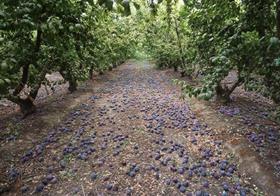
The Chilean Exporters Association (Asoex) has surveyed the country’s fresh produce industry to assess the condition of the infrastructure, including internal transportation, electrical and port services.
Despite Chile being hit by another major aftershock, measuring 5.9 on the Richter scale, reportedly provoking widespread panic yesterday (3 March), the association said it was confident that fruit supplies from the country will return to normal over the coming days.
According to Asoex, results indicate damage in major production areas and in the country's infrastructure, including packing stations and cold storage facilities.
An estimated 78 per cent of the damage occurred in regions VI, VII, Metropolitan Region and VIII, affecting mostly table grapes, apples, pears and blueberries.
Asoex said the consensus among exporters and growers, however, was that the critical issues would be resolved within the next five working days, with a return to relative normality imminent.
“Companies are showing the expected solidarity and are working together to ensure that the industry will be back on its feet and operating normally,” the group said in a statement.
The association said the Chilean authorities had begun the task of repairing roads and bridges that were crucial to the transport of fruit from the growing areas to the ports.
“Since last Saturday’s earthquake, most areas have remained connected through alternative routes, but there have been inevitable delays in arrival times,” said Asoex.
As of Wednesday, Santiago Airport has begun servicing both incoming and outgoing flights from most major airlines for international and domestic routes, albeit with some key delays. It is expected to take some days before the airport returns to full capacity.
Asoex said the country’s main port of Valparaíso was loading from piers 1, 2, 3 and 6, and working at 90 per cent capacity, while the northern port of Coquimbo was operating normally and receiving fruit that had been redirected from other ports.
Chile’s second-largest port, San Antonio, was reportedly operating at 60 per cent capacity through the terminal EPSA (Empresa Portuaria de San Antonio) via piers 4, 5, 6 and 7, while the STI (San Antonio Terminal Internacional) still lacked electrical supply.
The association said power was expected to return shortly to the facility, which would then be able to function at 90 per cent capability. The small amounts of fruits that were destined for the port of Lirquén were being forwarded to alternative ports.
With regard to fruit inspection sites servicing the US market, Asoex said all five facilities were up and running and receiving fruit for inspection.
Asoex chairman Ronald Bown said that although there were still some production areas, as well as packing and cold storage facilities that had either no electrical supply or had road infrastructure damage, complete electrical supply “should be restored within the next 48 hours”.
“All involved in the growing, harvesting and shipping of fresh fruit in Chile are committed to holding distribution disruptions to a minimum,” he said.
Asoex added that it would like to thank the international fruit community for its support and would like to emphasise that fruit growers and exporters in Chile are committed to reducing the impact of the tragedy.



